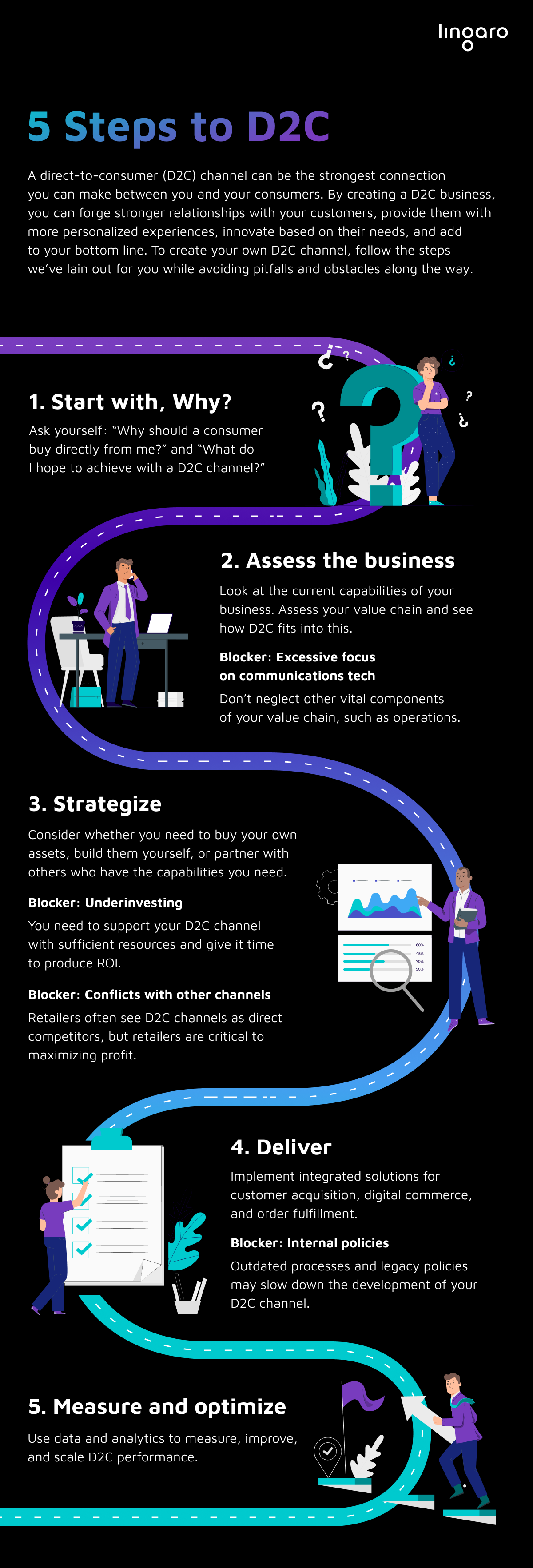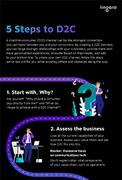For businesses building a direct-to-consumer (D2C) business, companies need to gain intimate knowledge about their consumers and derive actionable insights for driving innovation. D2C enables companies to own these. However, accessing consumer data is different from using it, and it requires the expertise to effectively act on it. Not every company has the technological and organizational capacity to use data to their advantage, let alone the capability to develop and implement a D2C strategy that contributes to the bottom line.
Nowadays, convenience and online experience are becoming as important as the products that the consumers buy, and whoever can forge more direct relationships with consumers — and deliver richer, more personalized experiences — is in a better position to stand out from the competition.
A direct-to-consumer (D2C) business model can empower companies to pave a closer digital path toward consumers by enabling their brands to deliver more unique and personalized experiences to consumers. It allows businesses to sell products directly to the consumer through platforms that they own or partner with (e.g., website, e-commerce store, app). In a D2C model, brands can integrate it into their digital ecosystem and own touchpoints across the consumer journey. This lets companies operate in ways where their products, business processes, and communications are optimized and differentiated for their target audience.
D2C isn’t going anywhere: In the US, D2C e-commerce sales is projected to grow to US$152 billion in 2022 and balloon to US$175 billion in 2023. Global brands and retail giants, too, are expected to carve their own niche in the D2C space, and they’ve started by investing heavily on order management, payment, and inventory control capabilities. Globally, 64% of consumers in 2022 are expected buy directly from a brand.
Why go direct to consumers
When implemented properly, a D2C strategy enables the business to:
Generate insights directly from customers and build their own communities. Companies can collect, consolidate, and own data directly from consumers to create feedback loops that help in improving the brand. Glossier, for instance, used social media to gauge what its followers liked (and didn't like) about their products and incentivizing their customers to spread the word about the brand. Now, it has a community of more than 2.7 million users on Instagram.
Build and differentiate the brand. Companies can incorporate services into a broader, more holistic offering to customers. Lego, for example, actively emphasizes themed play experiences — in fact, its digital platforms saw a 70% increase in content uploaded by its users in the first half of 2020, while their video platform is gaining more than a billion views as they establish a presence in China.
Fuel innovation. Companies can launch and test new, innovative products on a smaller scale but with a faster time to market, then adjust based on consumer feedback Kellogg’s used D2C platforms to incubate their emerging brands. They quickly launched their brands to just a handful of digital channels and emphasized sampling, focusing on testing and improving their products. These brands has since become available in grocery stores nationwide.
Grow revenue. Companies can drive and diversify sales by establishing direct connection with customers as well as increasing engagement and conversion rates through a digital commerce platform that they own or partner with. This is what consumer-packaged goods (CPG) companies such as AB InBev, Nestlé, Colgate-Palmolive, and Unilever have done for some of their brands.
Improve margins. Brands no longer need to outspend the competition for better in-store positioning and promotions via pricing or trade spend or by negotiating pricing with retailers for paper-thin margins. Nike’s gross margins in its D2C business, for instance, reached 62% in 2018 compared with 38% in its wholesale business.
Building a successful D2C business
M&M’S proved to be a D2C success story: Its D2C website was cited as the best in class among CPG brands, scoring high on its strong D2C capabilities as well as the brand’s discoverability, distribution, organic consumer enthusiasm, and product innovation. Coca-Cola, too, drew on their social media following to achieve loyalty, providing consumers with personalization, engaging content, and a differentiated portfolio of products that can only be found on their D2C channel. Their success stories have common denominators that companies can use as inspiration:

Start the strategy by answering, “Why?” Brands should first know its value proposition and how it can be delivered to them. Here are some starting points:
-
What is the role of D2C?
-
What is the strategy for assortment and pricing?
-
How will the company build capabilities?
Establish a road map and understand unit economics. Companies can start by:
-
Understanding key areas of the business. Define the value proposition and key objectives of the D2C business.
-
Analyzing the company’s current state. Assess the company’s readiness and build the business case for launching — or not launching — a D2C channel.
-
Developing a strategy or building a solution. This can entail strategies and solutions for executing a D2C channel (e.g., building a new one, partnering with digital retailers, acquiring an existing D2C company.
-
Delivering the solutions. These can be a combination of strategies and technologies as well as hybrid approaches and analytics tools.
-
Measuring and optimizing the D2C business. Gather feedback and use a data-driven approach to measure and improve business performance.
Define the D2C business’s operational model. This involves modernizing the company’s internal structures, business processes, and legacy IT systems as well as fostering a culture that empowers the people to be more data-driven and digitally native. There are other critical considerations, such as:
-
Define how the D2C channel contributes to the bottom line.
-
These costs encompass marketing and media investments, customer acquisition costs, expenses for keeping the supply chain running.
-
These include capabilities in technology, operations, and data and analytics centered around the consumer journey.
D2C is not just about selling online
Building a viable and competitive D2C channel requires sizable investments and significant transformation in how the company operates and how it does business with consumers, vendors, partners, and stakeholders. These might become barriers for some organizations, but these can also be seen as catalysts for innovation and stronger capability to learn from and connect with consumers. A D2C strategy can give brands competitive advantage by putting consumers at the heart of how the company operates while giving the business control of data as well as freedom to enrich consumer experience.
Download our white paper, “The Road to D2C: How To Pave a Closer Digital Path Toward Consumers,” which explores how companies can build a sustainable D2C business — the benefits it can bring, its opportunities, caveats, and risks, and real-life case studies of enterprises that have tapped into D2C’s promise and potential.
Lingaro Group’s digital commerce practice works with enterprises and global brands in designing, developing, and deploying e-commerce systems and digital marketplaces enabled by data and analytics. Our end-to-end solutions cover the entire journey in digital commerce — from strategic consulting, e-commerce strategy, IT architecture design, UI/UX prototyping and e-commerce development to D2C, B2C, and B2B platforms.








